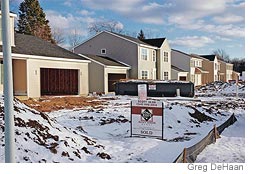Mrjoshua Member Username: Mrjoshua Post Number: 731 Registered: 03-2005 Posted From: 69.209.182.9 |
Civics Lesson Kalamazoo, Mich., Pegs Revitalization On a Tuition Plan Promise of College Funding Stokes Housing Demand, But Will Jobs Come, Too? 'Totally Awesome,' a Teen Says By NEAL E. BOUDETTE March 10, 2006; Page A1 KALAMAZOO, Mich. -- Last year, Greg DeHaan and his partner built 189 homes in the leafy, middle-class suburbs ringing this downtrodden industrial city, but not one in Kalamazoo itself. "There was no demand," says Mr. DeHaan, whose company, Allen Edwin Homes, is one of the largest home builders in Michigan. By early December, however, a market had suddenly materialized, prompting the developer to pay $7 million for three separate tracts of land. Out-of-state investors began scouring the area for opportunities, too. Mr. DeHaan and others in town trace this new interest in Kalamazoo to an unusual, anonymously funded plan. Beginning this June, college tuition will be free for any student who enters the Kalamazoo school system by the ninth grade -- regardless of income or need. The program, unveiled in November by the city's superintendent of schools and underwritten by a group of local philanthropists, is to run for at least 13 years.  Called the "Kalamazoo Promise," the tuition plan requires only that students live in Kalamazoo or neighboring Oshtemo township, graduate from public high school and attend a public university or community college in Michigan. Students who go from kindergarten through the 12th grade get a full ride. The program will cover 65% of tuition costs for those who spend at least their four high-school years in the city's schools, with the percentage of aid rising for those who spend more years in the system. With its commitment to the Promise, Kalamazoo is upsetting the traditional economic-development model. In the past, blighted cities across the nation signed onto various types of revitalization plans. Mainly, they focused on physical improvements -- including new public spaces, office parks and other civic amenities -- in hopes of spurring economic and social progress. The Promise is different. By making education the cornerstone of the city's turnaround plan, Kalamazoo is hoping that other positive changes will follow. Mr. DeHaan, the developer, says the Promise already has helped fuel housing demand. His company plans to put up 70 houses in Kalamazoo this year, and perhaps 500 over the next five years. Suburbanites have begun moving into the city. Both families and investors from outside the state are hunting for property, which has seen modest price increases. What isn't clear is whether the Promise will bring much-needed jobs to Kalamazoo. Although the plan hasn't lured any companies yet, Southwest Michigan First, a regional development agency, says the number of inquiries from small businesses has recently quadrupled to between 20 to 25 calls a week. Economic Benefits John Austin, a nonresident fellow at the Brookings Institution, suspects the Promise will have a big economic punch in the long run. "The places that produce and attract talented people are going to be the places that participate in today's economy," he says. "Your economic future is linked to how many people get to post-secondary higher education and how many you can keep in the community."  William Johnston, the founder of the Greenleaf Cos., a local investment group, is confident that the Promise is "a jump-start" for the city's economy -- one that is more compelling than tax breaks or similar incentives. "It designates Kalamazoo as education-minded," Mr. Johnston says. "And high on the list of employers' minds today is the quality of the schools." Kalamazoo's population of 77,000 is roughly 70% white and has a mix of blue-collar and middle-class neighborhoods. Waves of plant closings, including Upjohn Co. and General Motors Corp., have left the once-affluent city with a depleted center and a poverty rate of 25%. Those trends alarmed local residents and prompted meetings among various government, business and education leaders. "We gathered together all the stakeholders and looked at the overall health of the county," Mr. Johnston says. Many in Kalamazoo speculate that Mr. Johnston and his wife, Ronda Stryker, a member of the family that founded medical-devices maker Stryker Corp., are among the donors. (He says only that "the donors have requested anonymity.") A few years ago, a group of wealthy individuals began discussing the same issues in private, and invited Janice Brown, the superintendent of schools, to join them. Over time, the group focused its talks on the link between jobs and education. "One of the conclusions was that a better economy was going to require a healthier Kalamazoo school system," Mr. Johnston says. Eventually, recalls Dr. Brown, one of the group's members posed a question: "What if everyone got free college tuition?" The idea seemed to strike at the heart of a problem facing cities in the Midwest, now in a painful economic transition. In the past, all around the Great Lakes, a high-school diploma was all that was needed to get a factory job paying good, middle-class wages. Over the past two decades, the Midwest has struggled to shift away from manufacturing toward what is often called the "knowledge-based economy" -- newer, advanced industries and professions that require more education. Forty years ago, Kalamazoo was a rarity among the industrial cities of the Midwest. It was home to plenty of gritty factories, like the half dozen or so paper plants along the Kalamazoo River and the Checker Motors Corp. plant that made taxicabs. A General Motors stamping plant employed more than 3,000 well-paid union workers.  But the city also had an artsy, affluent side. Downtown featured an elaborate, European-style pedestrian mall with fountains and tall evergreens. In the hilly neighborhoods southwest of the city's center, well-paid scientists and researchers lived in stately homes. A city symphony, a lively arts community and the city's schools flourished, thanks in part to backing from wealthy families such as the Upjohns and the Strykers. Today, Kalamazoo looks more like other cities across the Rust Belt. At the closed Checker plant, the hulks of junked cabs are lined up behind a battered chain-link fence. Near the river, windows are cracked and paint peeling at the shuttered Georgia Pacific paper mill. The donors think the Promise "is the way to revitalize their city," says Dr. Brown, who is one of the few people in the city who knows their identities. They believe that "equal access to higher education for all creates a powerful incentive that will bring people and employers back to Kalamazoo." By last September, the group had a plan in place. Unlike some other free-tuition programs, which often limit eligibility, the Promise was designed to serve as many students as possible, with no grade-point requirements. All Kalamazoo residents who graduate from high school and are accepted at public Michigan colleges will qualify -- including students applying to community colleges. The public got its first word of the Promise on Nov. 10, when parents, students and local reporters were urged to attend a school-board meeting. The regular agenda was tabled and Dr. Brown took the microphone, saying "a group of donors who understand that education equals economics are making an investment in our students." When she finished, the crowd gasped, then began clapping. Parents and board members wiped away tears. At a gathering across town, people watching the meeting on television "were crying and hugging, just going crazy," said Dick Stewart, whose daughter is a junior and eligible to have 65% of her tuition covered. "It was one of the coolest things I've ever witnessed." The Promise will cover tuition costs -- which range from about $1,700 a year for community colleges to almost $9,000 a year at the University of Michigan -- but not room and board. Bills are to be paid by the donors, with no money going directly to students or their families. Cost Estimates The school department estimates it will cost about $3.5 million to send this year's crop of about 500 graduates to college, and sees the annual cost rising to $12 million or more over the next four years. More details of the plan are expected to be announced next week. For Megan VanOrsdol, a 17-year-old junior at Loy Norrix High School who wants to go into broadcasting, the Promise has broadened her choices. Worried about the cost of college, her parents had been pushing her to get a two-year nursing degree.  Five homes at the Nichols Landing development in Kalamazoo, Mich., are nearing completion. These lots sat empty for three years until the 'Kalamazoo Promise' was announced. But now that she can count on the Promise to pay 70% of her tuition, Ms. VanOrsdol is looking at communications programs at Michigan schools. "I'm totally going and my parents are totally supporting me and it's totally awesome," she says. After the announcement, Mr. DeHaan, the developer, was calling around Kalamazoo to check out property deals. One small development, called Nichols Landing, caught his eye and he snapped up 19 vacant lots. By February, five new homes were nearly completed. Three had already sold. One other lot was purchased by Corey and Dan Reed. Although Mr. Reed's business, a mortgage lending company, is based in Kalamazoo, the couple had always thought the suburb of Parchment a better place to raise their two daughters, ages 8 and 6. With less money needed for college, Ms. Reed, 32, is planning on being a stay-at-home mom for at least a few more years. "That's a big quality-of-life issue," she says. In Kalamazoo, the Reeds were also able to get more house for their money. Their four-bedroom home under construction at Nichols Landing had a base price of $175,000. But anticipating savings from the Promise, they added $35,000 of upgrades, including a kitchen island and hardwood floors. The plan even has attracted people outside of Michigan. In Arizona, Maria Buccilli, a single mother, had considered going to graduate school at Western Michigan University in Kalamazoo. The lure of free tuition for her three grade-schoolers prompted her to act. Last month she bought a four-bedroom home in Kalamazoo for $175,000, about $100,000 less than she expects to get for her three-bedroom house in Tucson. Meanwhile, other communities and businesses are watching. A delegation from Philadelphia visited Kalamazoo in February to learn about the Promise. Newton, Iowa -- which is bracing for job losses now that its main employer, Maytag Corp., is in the process of being acquired by Whirlpool Corp. -- is trying to pass a sales tax to fund a Newton Promise scholarship program modeled after Kalamazoo's. Kim Didier, executive director of Newton Development Corp., says that the Promise -- though still unproven -- is a compelling economic model. "What sets you apart is the skills and quality of your work force," Ms. Didier says. Enrollment in the city's schools has been declining for years, but in February 277 youngsters registered to start kindergarten next September -- up from 193 last year. Write to Neal E. Boudette at neal.boudette@wsj.com | ||
Focusonthed Member Username: Focusonthed Post Number: 37 Registered: 02-2006 Posted From: 209.220.229.254 |
Wow...they painted Kalamazoo as quite the shithole. It is certainly not. | ||
Machoken Member Username: Machoken Post Number: 1145 Registered: 10-2003 Posted From: 207.145.38.104 |
I think the characterization of Kzoo is somewhat accurate. The areas that are inundated with WMU and Kzoo college students are okay, but the non-student neighborhoods, especially those on the south side of downtown, aren't all that great - they're lower middle class at best. They could have mentioned that some areas of Kzoo proper are thriving I suppose, but those areas generally are not populated by the people who are to benefit from the Kalamazoo Promise, and so it doesn't necessarily add much to the article. (Message edited by machoken on March 10, 2006) |